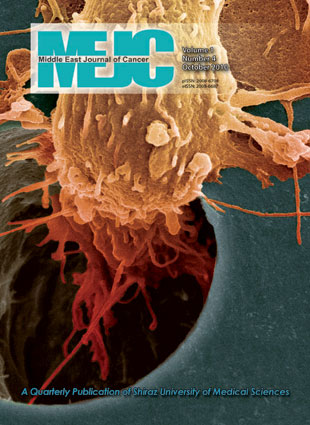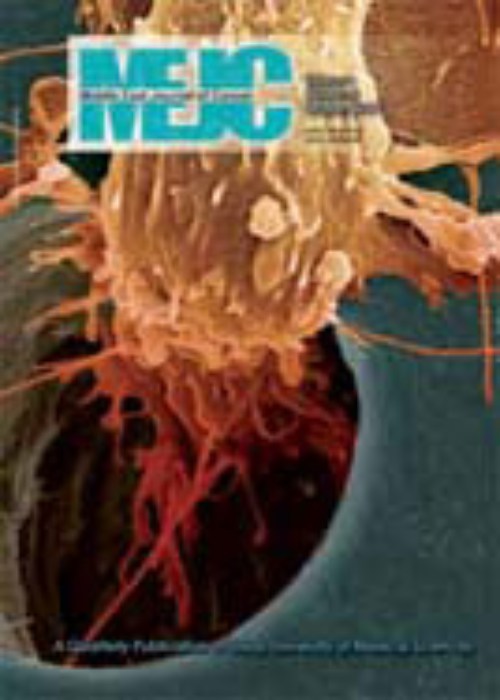فهرست مطالب

Middle East Journal of Cancer
Volume:1 Issue: 4, Oct 2010
- تاریخ انتشار: 1389/10/11
- تعداد عناوین: 8
-
-
Page 155BackgroundSentinel lymph node biopsy is a technique used to identify the axillary node most likely to contain tumor cells that have metastasized from a primary carcinoma of the breast. This technique provides accurate staging with fewercomplications than axillary dissection and may result in decreased costs. We designed the present study to determine the accuracy and success rate of a combined blue dye and radioactive tracer technique in sentinel node localization.MethodsThis prospective study included 70 patients with early stage (tumor>5 cm; T1, T2) operable breast cancer and nonpalpable axillary lymphadenopathy seen between 2005 and 2009. Patients underwent sentinel lymph node localization using 4 mL of blue dye combined with radioactive colloid. After identification and removal of the sentinel node(s), the axilla was checked for any residual radioactivity. A sentinel node was defined as any node that was hot, hot and blue or only blue.ResultsThe sentinel node was identified in 66 patients with a detection rate of 94.2%, and a mean of 1.5 sentinel nodes were identified and harvested (range of 1-4). In 23 cases, the sentinel lymph node contained metastatic disease on pathological assessment. There was no pathological evidence of any metastases in the sentinel node in the remaining 43 patients. All sentinel lymph nodes were located in level I of the axillary region. In four patients, no sentinel lymph node was found, so axillary dissection was performed. The sensitivity of the procedure in predicting further axillary disease was95.6% with a specificity of 97.6%.ConclusionThe present study describes the blue dye and radioisotope localization technique as successful in identifying the sentinel lymph node in early-stage breast cancer patients.
-
Page 159BackgroundBreast cancer, a critical health problem, is considered to be a progressive disease with a poor prognosis if detected late. Public education about the disease plays a pivotal role in early detection and subsequent improvements in prognosis. The present study assesses the knowledge and awareness about various aspects of breast cancer among female university students.MethodsThe knowledge of various aspects of breast cancer including incidence, early warning signs, risk factors, screening, early detection measures and sources of information was evaluated among female students in different faculties of Taibah University, Al Madina Al Munawara, Saudi Arabia, from December 1 to 31, 2008. A self-structured validated questionnaire that contained 23 itemized questions about breast cancer was randomly distributed to the participants. Respondents’ levels of knowledge were determined and transferred to electronic spreadsheets for further analysis.ResultsOf 301 students, 247 (82%) were available for final analysis with a mean age of 27 years (SD 12.1; age range: 18 to 39 years). Two hundred eleven (85.4%) respondents were single, 218 (88%) nulliparous and 213 (86%) had no family history of breast cancer. Their knowledge about the incidence of the disease was poor; only 34% replied correctly. A total of 148 (59.9%) respondents mentioned swelling in the skin/axilla while 123 (49.7%) suggested skin changes as early warning signs of breast cancer. None of the participants expressed knowledge about all established risk factors of the disease. One hundred fifty-nine (64.4%) did not know the proper way to perform a breast self-examination and 104 (42.2%) had never performed this test. Additionally, 128 (51.8%) knew that mammography was a screening tool for breast cancer. Sources of information about the disease were: television and radio (139, 56.2%), printed material in journals and newspapers (86, 34.8%) and family physicians (13,15.2%).ConclusionThis study revealed that respondents showed deficient knowledge about key issues concerning breast cancer and its early detection measures. It also revealed that health workers were not the main source of information in the community, thereby posing a challenge for community health services to provide basic required information about breast cancer.
-
Page 167BackgroundSafe dose escalation is highly desirable in radiotherapy for prostate cancer. Prostate displacement due to bladder filling can be significant, so improved targeting of the prostate by ultrasound imaging potentially allows for a reduction in the target margin and consequently less toxicity. This study estimates the accuracy of ultrasound for prostate and bladder volume measurements by comparing ultrasound images taken immediately before and after magnetic resonance imaging to reduce the effect of organ filling on measurement accuracy.MethodsThree patients with a wide range of prostate sizes underwent pelvic magnetic resonance imaging and ultrasound imaging. We tested the correlation between the two measurements and the differences between the ultrasound measurements before and after magnetic resonance imaging using statistical analysis.ResultsBased on a total number of 18 volume measurements, a strong linear correlation was found (r=0.95), but there were no significant differences between ultrasound imaging performed before and after magnetic resonance imaging (P=0.809).ConclusionOur results provide additional evidence that ultrasound imaging measures bladder and prostate volumes in a reproducible and accurate manner over a wide range of volumes, which enables its use with different fractions of prostate radiotherapy.
-
Page 175BackgroundThe aim of this study was to explore Saudi cancer patient's views regarding cancer information disclosure and whether differences existed between regions or gender.MethodsIn this cross-sectional questionnaire-based prospective survey, we interviewed 332 Saudi cancer patients who received oncological care at King Fahd University Hospital, Al-Khobar, Saudi Arabia from July 2002 to July 2009 to explore their attitudes regarding disclosure of cancer information.ResultsThe vast majority of Saudi cancer patients wanted to know the diagnosis of cancer (98%) and only 2% wanted the information to remain undisclosed. Seventy percent of the women wanted family members to know compared to only 39% of the men (P<0.001). Only 10% of the patients wanted their friends to know. In this study, 99% and 98%, respectively, wanted to know about the benefits of therapy and about their diagnosis of cancer. Of both genders, 98% also wanted to know the side effects of therapy and the prognosis. The attitudes of Saudi men and women with cancer were almost identical apart from sharing information with their family members. 99% of eastern region cancer patients wanted the diagnosis of cancer disclosed compared to 74% of those from other regions (P=0.04).ConclusionThe findings of this study indicated that most Saudi cancer patients wanted disclosure of cancer information. Significantly more women than men wanted to share information with their family. More Eastern region patients wanted to know about their diagnosis of cancer compared to patients from other regions.
-
Page 181Basal cell carcinoma (BCC) is the most common cancer among humans, and the standard treatment is surgery. Other modalities are reserved as a second line of treatment. Topical chemotherapy may be used in primary BCC. Systemic chemotherapy has no role in the primary treatment of BCC, although it may be efficacious in metastatic cases. We report the case of a patient with persistent recurrent BCC following multiple surgeries and radiotherapy, who achieved a dramatic response with a cisplatin and 5-flourouracil chemotherapy regimen.
-
Page 185Isolated skeletal metastasis to the bony calvarium is extremely rare in patients with squamous cell carcinoma of the uterine cervix. We describe the clinical and imaging findings in a case of squamous cell carcinoma of the uterine cervix with metastases to the bony calvarium as the sole site of metastasis. The patient was a 65-year-old woman with squamous cell carcinoma of the uterine cervix, FIGO stage IIIb, whose initial treatement was chemoradiation therapy. After 22 sessions of external-beam radiation, she developed headaches. On physical examination she had skull bone tenderness. On plain skull X-ray, there were osteolytic bony lesions. Brain MRI showed multiple enhancing skull bone metatstses. Eventually, a whole body bone scintigraphy revealed isolated diffuse increased activity in the bony calvarium. In the literature review, we found only three similar cases of cervical cancer with scalp metastases and involvement of the bony calvarium.


